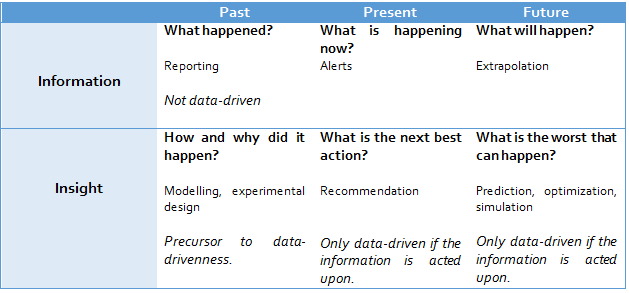What does it mean to be a Data-Driven Organisation?
Without data you are just another person with an opinion
Williams Edwards Deming
Over recent years, the use of data has substantially increased due to new technologies that allow for more efficient storage of data and presentation of information. Data has become a hot topic and becoming a data-driven organization has become a strategic pillar towards attaining competitive advantage.
But… what does it really mean in practice to be a data-driven organization?

Data-drivenness is about building the tools, abilities and – most important – the culture that acts on data.
If your organization wants to go down this road, there are some prerequisites that are a must in the first place:
- You must be collecting data…. The right data! Meaning that it needs to be accurate, clean, unbiased – and most importantly – trustworthy.
- This data needs to be accessible and queryable.
- It needs to be in a form in which can be joined to other enterprise data when necessary to allow you to produce deeper and richer analysis.
- There needs to be a data-sharing culture within your organization. Siloed data is always going to inhibit the scope of what can be achieved. When more data is available to more parts of a system, the whole system is greater than the sum of the parts.
- The appropriate tools need to be in place to be able to query and slice and dice the data with the aim of being able to report what is happening in an organization.
However, data on its own is not sufficient. Your organization needs people with the right skills to extract that data and metrics to answer the questions that you might have as a business.
From reporting to analytics

Let us assume your company has an analytical team with access to the data, who present a report showing a month-on-month increase in sales. Well, this is a good step towards being a more data-driven organization, but unfortunately, it is still insufficient. Why? Because this is just a numerical value with little to no context. Analytics is much more than that.
- Reporting is a process whereby data is organized in informational summaries to monitor how different areas of business are performing. It explains what happened in the past in a backward view of the world.
- The function of analytics is completely different, its mission is to transform the data assets of any organization into competitive insights that will help organizations to drive decisions and actions using people, processes, and technologies. It is a completely forward-looking approach to finding out why numbers change.

Seeing the differences above between reporting and analytics helps to understand why analysis and being data-driven is such a powerful facet or cultural component of a business. It is what can drive an organization to new directions or to greater levels of efficiency.
A useful framework to clearly understand the main differences in analytics and reporting is the one presented by Davenport in his famous article Competing on Analytics. Davenport hypothesized key questions addressed by analytics:

Hallmarks of data-drivenness
There are several types of activities that truly data-driven organizations engage in:
- A data-driven organization may be continuously testing;
- A data-driven organization may have a continuous improvement mindset;
- A data-driven organization may be involved in predictive modeling and forecasting activities;
- A data-driven organization will almost certainly be choosing among future options or actions using a suite of weighted variables.
A truly data-driven organization will be doing at least one of these things, something progressive where data is a first-class citizen.
At this stage, we have covered the importance of the availability of proper data and skillsets as the engine of a data-driven organization. But there is another critical cog in successfully being truly data-driven. Data needs to be acted upon. What is the point of having data analysts producing analysis, but no one acting on it? Analytics must inform and influence the influencers.
Let us look at the below figure that summarizes the analytics value chain:

The last two aspects of the process depict how analysis has to get to the decision-maker, who incorporates those into their decision-making, in turn changing strategy or tactics and making an impact on the organization.
And to arrive at this point of ‘data enlightenment’, technology and training are not enough. Culture plays a vital role in setting up the mindset and process to take notice of those findings, trusting them, and acting upon them.
Analytics Maturity: know where your organization stands.
One simple way to see where your organization stands is to have a look at the classical analytics maturity model presented by Davenport in his famous work on Competing on Analytics. In the figure below, analytics is presented as a staircase, where you climb to the next level only after conquering the previous one:

Unfortunately, the reality is far from that simplistic view: analytics cuts across levels within an analysis, and different parts of the organization can be engaged in the analysis of differing degrees of sophistication at any one time.
Following this reasoning, another more meaningful approach is to assess analytics maturity from a more holistic view. In an interesting study from MIT Sloan Management Review, the authors came up with the below table establishing different levels – aspirational, experienced, and transformed – after running a survey to more than 3000 managers and analysts across different industries:

Interested in adopting a more data-driven approach for your organization? Want to increase the analytic capabilities but you do not know where to start? Get in touch with us for a free consultation. We have wide experience helping companies across different sectors in getting the most of their data to drive their business.
